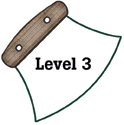
Alaska Science
Key Element A6
A student who meets the content standard should understand that forces of nature cause different types of motion, and describe the relationship between these forces and motion (Motion).
 |
Alaska Science A student who meets the content standard should understand that forces of nature cause different types of motion, and describe the relationship between these forces and motion (Motion). |
|
Performance Standard Level 3, Ages 11–14
|
|
|
|
Sample Assessment Ideas
|
|
|
Expanded Sample Assessment Idea
|
|
Materials “Marbles” of different materials (ball bearings, glass marbles, plastic balls, etc.), thin card or wood to make “chutes”, rulers or meter sticks. Procedure Students will:
Reflection and Revision
|
Levels of Performance |
||
|
Stage 4 |
Student work is complete, correct, and shows detailed evidence of the transfer and extension of knowledge that relates forces to changes in motion. Data tables and graphs are clearly labeled, well-organized and accurately represent the observations. All five force diagrams are clearly labeled to show the appropriate forces and resulting motion. The discussion shows excellent reasoning skills, recognizes that the amount of “force” determines the motion, that a constant force (gravity) is applied down the chute, and that no new force is applied once the marble leaves the bottom of the chute, and includes a detailed error analysis section. | ||
|
Stage 3
|
Student work is mostly correct, and shows evidence of the transfer or extension of knowledge that relates forces to changes in motion. Data tables and graphs are labeled, organized and reasonable representations of the observations. Most of the force diagrams are labeled to show the appropriate force and resulting motion, although they may contain minor errors or omissions. The discussion shows reasoning skills, recognizes that force determines the motion, that a constant force (gravity) is applied down the chute, and includes an error analysis section. | ||
|
Stage 2
|
Student records some data and attempts to graph. In discussion shows limited logical reasoning. May not recognize clearly the amount or origin of “force” that determines results, or that other variables need to be controlled. May recognize that some variables need to be controlled, but is unclear on details. | ||
|
Stage 1
|
Student work is mostly incomplete, contains misconceptions relating to force and motion, data records are minimal or totally incorrect, and interpretations show limited scientific reasoning. | ||
Standards Cross-References
|
||
|
National Science Education Standards The motion of an object can be described by its position, direction of motion, and speed. That motion can be measured and represented on a graph. (Page 154) An object that is not being subjected to a force will continue to move at a constant speed and in a straight line. (Page 154) If more than one force acts on an object along a straight line, then the forces will reinforce or cancel one another, depending on their direction and magnitude. Unbalanced forces will cause changes in the speed or direction of an object’s motion. (Page 154) |
Benchmarks An unbalanced force acting on an object changes its speed or direction of motion, or both. If the force acts toward a single center, the object’s path may curve into an orbit around the center. (Page 90) Vibrations in materials set up wavelike disturbances that spread away from the source. Sound and earthquake waves are examples. These and other waves move at different speeds in different materials. (Page 90) Human eyes respond to only a narrow range of wavelengths of electromagnetic radiation—visible light. Differences of wavelength within that range are perceived as differences in color. (Page 90) |
|
Table of Contents | Return to Alaska Native Knowledge Network